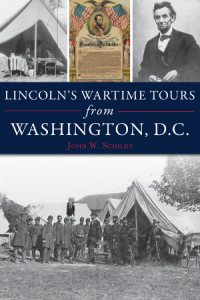For a better future, study the past.
Menu
For a better future, study the past.
Schildt, John W. Lincoln’s Wartime Tours from Washington D.C. Charleston: Arcadia Publishing, 2020. ISBN 9781467145718, 172 pages, 153 pages of text, index, bibliography, notes, b/w photos, $21.99.

Has there ever been a more written about person that Abraham Lincoln? Ford’s Theatre houses a 34 foot book tower to the Great Emancipator, while estimating the number of titles published is more than 15,000. Moreover, every year more titles are released not even taking into account journal, magazine, and newspaper articles. Authors and publishers continue to find aspects of Lincoln’s life that have not been directly addressed, new interpretations are provided, and in some cases authors just rehash other secondary materials. The historiography is mind boggling.
Adding to the literature is John Schildt, a certified battlefield guide at Antietam National Battlefield, who has penned a new book discussing the travels made by Lincoln while he served as president. In total, Schildt covers nineteen wartime trips Lincoln made outside of Washington D.C. These trips became less frequent as the war dragged on; beginning with nine in 1862, five in 1863, four in 1864, and a single trip in 1865. (page 18) As would be expected these sojourns were made close to Washington D.C.; visiting Virginia, Maryland, Pennsylvania, and New York.
The author proposes that these trips were made for three specific reasons. The first was to confer with generals, second to plot military strategy, and a third reason was to visit troops in the field. (pages 16- 17). The president seemed genuinely concerned for the combatants whether they be Union or Confederate. An example being provided in a lengthy quote from the Donald C. Pfanz work Lincoln at City Point, where the president is seen moving through the tents of injured men, shaking hands, offering encouragement, sharing a tear, and telling them they had to live. When it came to Confederates, Lincoln was known to visit those who were confined to hospitals. Lincoln is shown to be a truly benevolent leader. (pages 141-145)
A continuing thread about family, in particular Mary Lincoln, runs throughout the work. Mary is often seen as difficult, jealous, and perhaps another reason for Lincoln to have tried to escape D.C. for these short periods. Tad is shown to be a boy, doing boy things, and having boyish reactions. During the 1865 trip to Virginia, the presidential entourage came across three pound bales of tobacco that some of the adults took for their own use. Tad joined in and grabbed some as well despite being too young to smoke. (pages 126-127)
Some of the visits are better known than others. The trip to Gettysburg is well documented and Lincoln’s “few appropriate remarks” is perhaps the most widely known speech of all time. Other tours are less well known and herein lies the value of the book. For those seeking a concise and easy to digest book outlining a unique aspect of Lincoln’s life this is recommended. The endnotes, more than 200 of them, are helpful for those looking for further documentation.
Thank you to Arcadia Publishing for providing a complimentary review copy of this book.
This post may contain affiliate links. If you click these links and make a purchase, I may receive a small commission. This commission does not affect any price that you pay. All views and opinions provided are my own and are never influenced by affiliate programs or sponsors providing products.